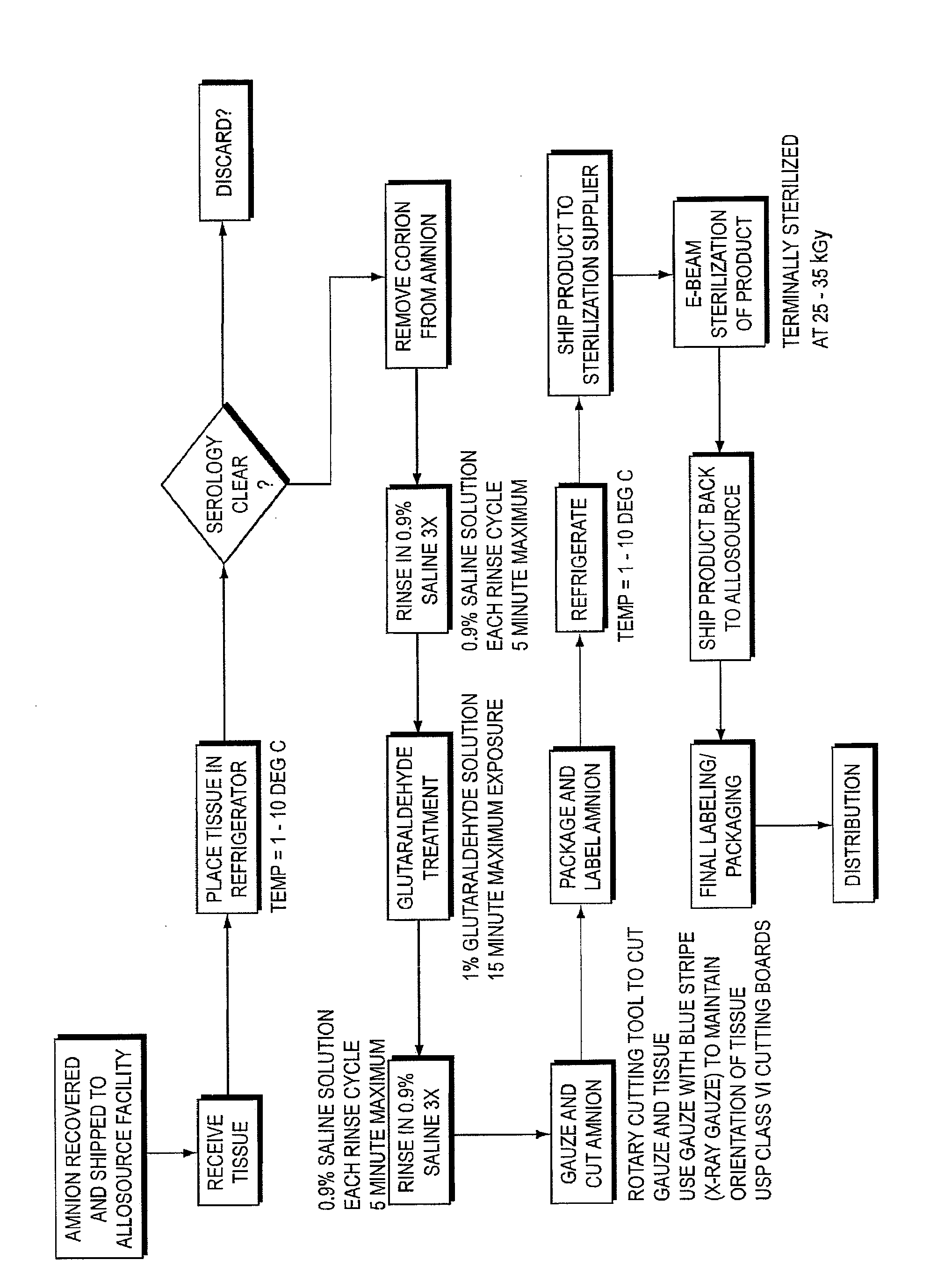Anti-Adhesion Barrier Wound Dressing Comprising Processed Amniotic Tissue and Method of Use
a barrier wound and amniotic tissue technology, applied in the field of anti-adhesion wound dressings, can solve the problems of difficult handling and manipulation of amnion, and achieve the effect of maintaining the orientation of the amnion patch and facilitating the handling of amnion
- Summary
- Abstract
- Description
- Claims
- Application Information
AI Technical Summary
Benefits of technology
Problems solved by technology
Method used
Image
Examples
example 1
Amnion Patch Treated with Glutaraldehyde Implanted with the Maternal Side Towards the Dura
[0035]Gluteraldehyde treated amnion patches were prepared using the method described above, with the patches treated in 1% gluteraldehyde solution for 15 minutes. Three saline rinses as described above were performed before and after the gluteraldehyde treatment. In this example, the amnion treated patches were implanted with the maternal side of the amnion towards the dura.
[0036]The pathologist's review revealed the following. The laminectomy site was filled completely with reactive bone, reactive fibrocartilaginous tissue and reactive fibrosis. The reactive bone was organized and extended from the ends of the adjacent vertebral bodies. Superficially, there were ligaments and skeletal muscle bundles with regional muscle fiber atrophy and endomysial fibrosis. Separated by a distinct linear clear zone was an underlying membrane with a simple layer of flattened cuboidal epithelioid cells upon a h...
example 2
Amnion Patch with Non-Treated Amnion Patches with the Fetal Side Towards the Dura
[0038]A group of sheep were implanted with amnion patches that were not treated with gluteraldehyde with the fetal side of the amnion toward the dura. The pathologist's review revealed the following. Embedded within the abundant reactive fibrosis filling the bone defect was a partial plicated membrane that was eosinophilic and acellular. It had “fragmentation” with fibrosis filling the defects. There was intimately associated mild lymphocytic inflammation forming a single lymphofollicular structure. There was extensive fibrosis of the dura that was continuous with the filling fibrosis. A summary of the findings is presented in Table 4.
TABLE 4Non-treated amnion patch, Fetal side towards the Duraadhesion-adhesion-Sectionmembraneinflammation-inflammation-fill fibrosis-Dural-sheeplam siteLevelmembraneintactlymphgranulomatousfibrosismembranemembrane2Acran1122321middle1022322caudal10223224Bcran1132322middle11...
example 3
Glutaraldehyde Treated Amnion Patch with the Fetal Side Towards the Dura
[0039]Gluteraldehyde treated amnion patches were prepared using the method described above, with the patches treated in 1% gluteraldehyde solution for 15 minutes. Three saline rinses as described above were performed before and after the gluteraldehyde treatment. In this example, the amnion treated patches were implanted with the fetal side of the amnion towards the dura.
[0040]The pathologist's review of the histology slides revealed the following. The laminectomy site was filled completely with reactive bone, reactive fibrocartilaginous tissue and reactive fibrosis. The reactive bone was organized and extended from the ends of the adjacent vertebral bodies. Superficially there were ligaments and skeletal muscle bundles with regional muscle fiber atrophy and endomysial fibrosis. There was a distinct linear eosinophilic membrane lined by a simple layer of flattened cuboidal epithelioid that was on the dural side ...
PUM
 Login to View More
Login to View More Abstract
Description
Claims
Application Information
 Login to View More
Login to View More - R&D
- Intellectual Property
- Life Sciences
- Materials
- Tech Scout
- Unparalleled Data Quality
- Higher Quality Content
- 60% Fewer Hallucinations
Browse by: Latest US Patents, China's latest patents, Technical Efficacy Thesaurus, Application Domain, Technology Topic, Popular Technical Reports.
© 2025 PatSnap. All rights reserved.Legal|Privacy policy|Modern Slavery Act Transparency Statement|Sitemap|About US| Contact US: help@patsnap.com

